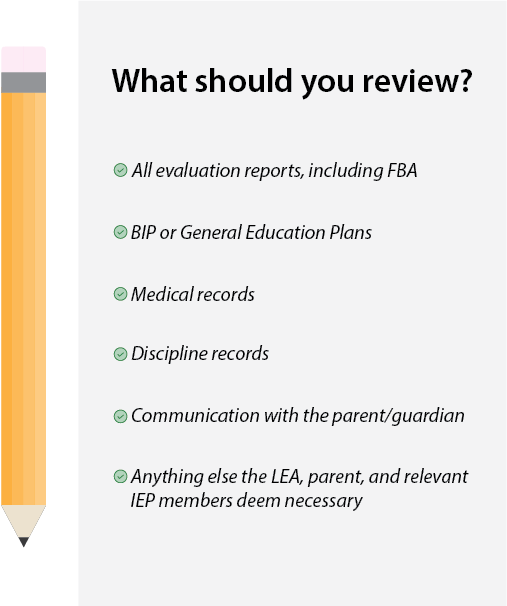Manifestation Determinations
The Individuals with Disabilities Education Act (IDEA) provides an additional level of protection for a student with a disability when they are subject to discipline after a violation of a code of student conduct. This protection is called “Manifestation Determination” and is activated when an eligible student has been removed from their educational placement for more than 10 school days. The manifestation determination helps to ensure that the school continues to offer a free and appropriate public education (FAPE) to all students, regardless of their disabilities.
Process Requirements
When a student is removed from their educational placement or denied their special education services for more than 10 school days, the following must be initiated or considered:
- When a disciplinary decision has been made, the parents are required to be notified that day and provided procedural safeguards which, every state has available on their respective Department of Education websites.
- The Local Educational Authority (LEA), parent, and relevant members of the IEP team must review information within 10 school days of the violation that disrupted the student’s current placement. This is often called the manifestation determination review (MDR).
- IDEA defines relevant information in the student’s file, as the following:
- The child’s Individualized Education Program
- Teacher observations
- Any relevant information provided by the parent
- IDEA defines relevant information in the student’s file, as the following:
- After reviewing this information, there is likely a form provided by the state to complete that assists in documenting the determination process.
- Web applications like SpedTrack provide a simple solution for completing state forms, all while providing the user a logical sequence to follow to ensure compliance.
- Based on the analysis of these documents, IDEA Section 1415 (k) (1) (E) (i) (I) states the manifestation determination team must decide “if the conduct in question was caused by, or had a direct and substantial relationship to, the child’s disability; or if the conduct in question was the direct result of the local educational agency’s failure to implement the IEP [Individualized Education Program].” This often occurs as a manifestation determination hearing (not synonymous with an IEP meeting).
- Consider the following when deciding this:
- The student’s area of eligibility
- Has the child’s behavior resulted in a removal of 10 consecutive school days?
- Have prior behaviors caused the student to accrue more than 10 nonconsecutive days of suspension?
- If this is the case, can a pattern of behavior and suspensions be identified that would constitute a change of placement? If so, the student’s conduct is likely a manifestation of the student’s disability. If not, the student can be removed; however, the district is still obligated to offer a free and appropriate public education (FAPE) to ensure progress is being made toward IEP goals, which provide access to the general education curriculum.
- When a student is removed from the general education setting, FAPE can be provided through:
- an interim alternative educational setting
- homebound service
- When a student is removed from the general education setting, FAPE can be provided through:
- If this is the case, can a pattern of behavior and suspensions be identified that would constitute a change of placement? If so, the student’s conduct is likely a manifestation of the student’s disability. If not, the student can be removed; however, the district is still obligated to offer a free and appropriate public education (FAPE) to ensure progress is being made toward IEP goals, which provide access to the general education curriculum.
- Does the student have a Behavior Intervention Plan (BIP) and has it been implemented with fidelity? If it has not, it is likely the direct result of the LEA’s failure to implement the IEP.
- Avoid this situation by maintaining a behavior log for students with a BIP who often display problematic behaviors in the educational environment.
- Consider the following when deciding this:

- If the child’s behavior was a manifestation of the disability or the failure of the LEA to implement the IEP appropriately, prepare to complete the following:
- Return the student to the placement from which they were removed
- Initiate a Functional Behavior Assessment and subsequently write a Behavior Intervention Plan for the student
- An existing BIP must be reviewed and amended if necessary.
- There are “special circumstances” for particularly dangerous violations of the student code of conduct that involve weapons, drugs, alcohol and serious bodily injury.
- When these situations arise, school districts may choose an interim alternative educational setting for the student in lieu of suspension. A student can be placed there for up to 45 days without having to consider a manifestation determination.
- Keep in mind, there are specific laws within various states that may require different types of disciplinary procedures for these types of offenses. Examples of those acts can be found in Texas, Missouri, and Arizona.
- In the end, a parent may challenge the district’s decision and request a due process hearing when there is a disagreement.
- Likewise, the school district can also pursue due process with a hearing officer when the local educational agency believes returning the student to their original educational placement is substantially likely to result in injury to the child or to others.
Considerations for Educational Placement Changes
With a topic like discipline being so divisive, the law may seem extremely vague. This appears especially true regarding the definition of a change in educational placement and what other types of relevant information must be reviewed.
Here are a few pitfalls school administrators will want to avoid:
- Days accrue over the course of a school year. The days of suspension do not have to be consecutive.
- In-school suspension (ISS) can be a change of educational placement if the student is denied access to their special education and related services. Meaning, the days in ISS the student does not access their services count toward the 10+ days that can trigger a manifestation determination hearing.
- If the student’s behavior has warranted In-school suspension, it is my suggestion that every service the student is provided is logged with date, time, and service provider. It would also be a good idea to have a brief description of the service provided. SpedTrack has a Services Tracking feature that streamlines this process and lets you run in-depth reports to know you are on track to provide the educational services you are legally required to provide! This documentation can help ensure the student is still offered and receives a free and appropriate public education (FAPE).
- In addition to ISS, partial day removals are also problematic. Often administrators do not view these as a suspension, but any removal, no matter how long, changes the educational placement of a student with a disability. Keep track of the hours, because enough of them will turn into a day or longer.
- Be aware that IDEA does not offer many suggestions of what to review, so let’s cover a few other items I believe the team should also consider:
- All evaluation reports, to include Functional Behavior Assessments (FBA)
- Behavior Intervention Plans (BIP) or General Education Behavior Plans
- Medical records
- Discipline records
- Communication with the student’s parent/guardian
- Anything else the LEA, parent, and the child’s IEP team members deem necessary

This list is hardly exhaustive but may allow you to think through things unique to a particular case you are working. Be sure to document all the team’s considerations and the artifacts they considered when making the determination.
Manifestation Determination Flowchart
I understand you may well be fatigued at this point; there are many nuances. To help, I want to provide a flow chart as a visual for the process:
Some states have their own flow charts to help school personnel visualize manifestation determinations like: Idaho, Oregon, and Ohio. It may be likely that your state has one as well.
Manifestation Determination Example 1
Sammy is a middle school student identified as having an Other Health Impairment due to ADHD, Combined Type. She rides bus #11 daily with her general education peers. On Wednesday, she shows students on the bus a baggie of dried green leaves stating that it was Marijuana. As bus #11 arrives at school, students tell the bus driver that Sammy has a bag of “weed.” The School Resource Officer (SRO) responds very quickly and searches Sammy’s backpack and finds the “drugs.”
After further investigation the SRO determines that it’s actually dried herbs for cooking. Sammy apologizes for bringing the baggie to school. School personnel and Sammy’s mother conduct a manifestation determination review and find that Sammy had not had other misbehavior this school year, nor had her general education teachers observed dangerous behaviors in class or in less structured school environments. The team considered Sammy’s IEP which had goals regarding following Multi-Step Directions and Task Initiations. Her Accommodations and Modifications were all academic in nature and behaviors impeding her education or the education of others had not been noted.
- Was this incident a manifestation of Sammy’s disability?
- It was certainly impulsive, but she had not demonstrated this behavior before
- She also had not had a history of this type of behaviors
- Sammy’s consequence was 45 days of suspension in an interim alternative educational setting. Does the district have to conduct a manifestation determination?
- No the school district does not have to consider if this behavior is a manifestation of her disability because of the special circumstances regarding illegal drugs and school
- Although Sammy did not actually bring drugs to school, she did present the herbs as an illegal substance. While she did not get a 180-day suspension, she did get suspended for more than 10 days.
Manifestation Determination Example 2
Chuck is a freshman in high school. He has been identified as a student with an Emotional Disturbance. He has a long history of hurting himself and others. Chuck has had a Behavior Intervention Plan since he was in Fourth Grade. Most of the time, Chuck becomes frustrated when he feels as though people in the room are making fun of him. His BIP states that when Chuck becomes frustrated, he will raise up two fingers and will be allowed to go to his safe space in Ms. Harris’s, the school psychologist, room. It also states that if Chuck does not raise his fingers but is observed by his teachers as being frustrated, they can provide a nonverbal cue to him by tapping lightly on his desk twice as a reminder that he can go to his safe space.
In American History class, Chuck thought a table mate was laughing at him and he yelled in the student’s face. The student then said, “Hey bro, I wasn’t even laughing at you!” Chuck stood up and punched the other student.
- Chuck left the room in tears and headed to Ms. Harris’s room
- The principal assigned Chuck 10 days of out-of-school suspension.
- Chuck has had 4 instances of behaviors that have resulted in OSS
- Yelling at a peer and using inappropriate language (1 day OSS)
- Slapping a peer on the back of the head (2 days OSS)
- Pushing a peer to the ground (4 days OSS)
- Is this behavior a manifestation of Chuck’s disability? OR; Was this the direct result of the LEA failing to implement the BIP or IEP?
- The MDR results in the Team saying yes, this is a manifestation of Chuck’s disability, but they have concerns about his safety and the safety of others. As a result of the determination, an IEP meeting was initiated, and the BIP was amended along with the Chuck’s educational placement. The team determined that a FAPE for Chuck is most appropriately served at a Special Day School, paid for by the sending school district.
Manifestation Determination Example 3
Keith is a first-grade student identified as having Autism. His first instinct when he sees a door is to run toward it. Keith has a social story that he and his teacher read every day that states when Keith is in the hallway, he has walking feet and holds his teacher’s hand. Keith does not have a BIP, but he does require visual supports to maintain expected behaviors, which is noted in his IEP.
On Monday, a delivery driver came to the school and propped the door open. Keith saw the door open and wiggled his hand free from his teacher. He sprinted toward the door and his teacher quickly followed. Keith was able to make it across the street into a group of houses before his teacher could catch him. The principal called Keith’s mother and explained the situation but also told her that he would be suspended for two days. Keith has been suspended for five days before because he bit his teacher when he did not want to hold her hand in the hallway. He has not bit anyone since that last time.
- Does the district have to conduct a manifestation determination?
- A manifestation would not have triggered in this situation because the student had not been removed from their current placement for more than 10 days.
- Keith could be removed from the educational environment like his peers without disabilities.
Manage Your Entire Special Education Process With SpedTrack
Manifestation determination can be a difficult concept to understand. The process is lengthy and can be time consuming.
Did you know that SpedTrack has built-in compliance tools that help you track various parts of the special education process (such as a manifestation determination)? If you want to see how it works, schedule a demonstration today!

















